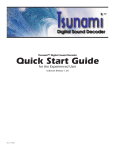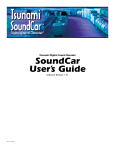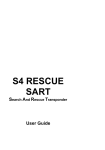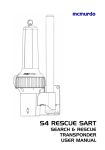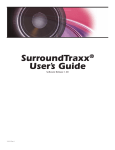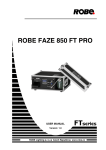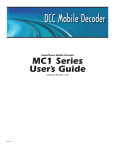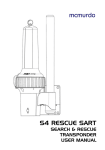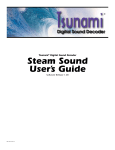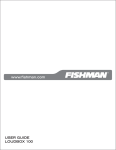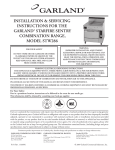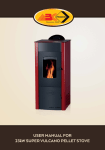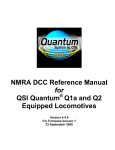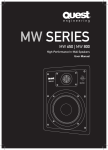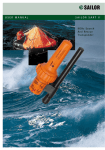Download Micro-Tsunami Quick Start Guide
Transcript
Micro-Tsunami® Digital Sound Decoder Quick Start Guide for the Experienced User Software Release 1.04 Notice The information in this document is subject to change without notice. SoundTraxx (Throttle Up!) shall not be liable for technical or editorial errors or omissions contained herein; nor for incidental or consequential damages resulting from the furnishing, performance or use of this material. This document contains information protected by copyright. No part of this document may be photocopied or reproduced in any form without the prior written consent of Throttle Up! Corp. Product names mentioned herein may be trademarks and/or registered trademarks of their respective companies. SoundTraxx and Tsunami are registered trademarks of Throttle Up! Corp. SoundTraxx DCC, Digital Sound Decoder, Dynamic Digital Exhaust, Auto-Exhaust and Hyperlight are trademarks of Throttle Up! Corp. Table of Contents All Aboard! ...........................................................................1 Overview................................................................................................1 Features ................................................................................................2 Reminder: Some Do’s and Don’ts .........................................................4 Installation ...........................................................................5 Basic Installation Guidelines .................................................................5 Installing the Digital Sound Decoder .....................................................6 Wiring the Decoder ................................................................................7 Installing Tsunami in a DCC-ready Model .............................................9 Operation ...........................................................................10 Quick Start ...........................................................................................10 Programming ..................................................................... 11 Programming and Reading CVs .......................................................... 11 List of Configuration Variables .............................................................12 Support...............................................................................13 Service and Warranty Policy ...............................................................13 All Aboard! Overview Congratulations on the purchase of your SoundTraxx® Micro-Tsunami® Digital Sound Decoder™. Properly installed, your Digital Sound Decoder (DSD) will provide all the pleasures of high quality, digital onboard sound and the benefits of today’s DCC (Digital Command Control) technology. With the proper tools, basic modeling skills and common sense, equipping a locomotive with sound is not difficult. It may, however, be a new experience for you, and you will find that successive installations will go more quickly than the first. Please note that while each decoder is tested thoroughly before it is shipped, we cannot control the correctness or quality of the installation. It is imperative that you follow the directions, and never remove the protective heat shrink from the decoder; there are no adjustments or user serviceable parts and this will void your warranty. This Quick Start Guide assumes that you have some understanding of or experience with other SoundTraxx Digital Sound Decoders. It covers the differences you may need to know between these decoders and any you may have previously used. If you are new to SoundTraxx Digital Sound Decoders, you should start with the Installation Guide, which will give you step-by-step instructions for a successful first installation. The User’s Guide will walk you through the various aspects of programming your Tsunami decoder, as well as some tips on troubleshooting. For the power user, the Tsunami Technical Reference will provide a list of all the CVs available for use with Tsunami decoders and their exact function and make-up for those who wish to have a complete reference for advanced programming techniques. Technical Bulletins and Application Notes covering various topics are also published from time to time, and these may be downloaded free of charge from our website at www.soundtraxx.com. Micro-Tsunami Quick Start Guide Page 1 All Aboard! Tsunami Features Tsunami Digital Sound Decoders have a great number of new features designed to enhance your operating experience. Many features operate similarly to previous SoundTraxx decoders, but some features will require a little explanation. Some of the enhancements include: Decoder Features • • • Supports extended address mode for assigning any locomotive number up to 9,999. Supports advanced consist addressing. Supports ‘Operation Mode Programming’, allowing CVs to be changed on the mainline without using a programming track. Sound Features There are many new sound effects (now over 20 sound effects!) and the ability to adjust the sounds to suit your ear (and model) has been greatly expanded and improved. You can now adjust the volume of each sound effect individually with Tsunami’s built-in mixer! The addition of a short whistle/horn effect will allow you to more easily incorporate signaling practices into your operations. There is also the option of replacing the short whistle function with an alternate whistle or horn for the engine which carried two whistles or occasionally, a horn and a whistle. For those with limited function keys, you may wish to enable the automatic signal feature, which will activate Stop, Forward, Reverse and Grade Crossing whistle signals automatically in response to train motion. More Sound Features • Adjustable Volume Controls • 1-Watt Audio Amplifier • Seven-Band Equalizer • Adjustable Reverb • Auto-Exhaust™ allows chuff to be synchronized to the locomotive speed without a synchronizing exhaust cam (steam); cam is optional. Steam Sound Effects • Steam Exhaust Chuff • Bell • Whistle • Short Whistle • Airpump • Dynamo • Water Stop • Brake Squeal • Brake Release • Side Rod Clank • Snifter Valve • Injectors • Johnson Bar/Power Reverser • Firebox Blower • Steam Release • Boiler Pop Valve • Fireman Fred’s tool box (5 effects) • Coupler Clank • Dynamic Digital Exhaust™ modifies exhaust volume, cutoff and timbre as locomotive load changes. Micro-Tsunami Quick Start Guide Page 2 All Aboard! Throttle Features Tsunami Digital Sound Decoders have greatly improved throttle features built into our Hyperdrive system. With the addition of these features, you will be able to better eliminate motor noise, better control your locomotive speed under varying conditions and adjust for differences between various manufacturers’ models. • • • • • Supports 14, 28 and 128 speed step modes. Programmable acceleration, deceleration and starting voltage for prototypical starting and stopping. Use of standard and alternate speed tables. Load Compensation Silent High Frequency Motor Drive Lighting Features All of our Hyperlight effects are available in our Tsunami decoders. One new addition, the Dyno-Light, provides the missing element in the operation of the Dynamo, or steam generator. This mimics the effect of the gradual increase in brightness as the generator spools up and supplies power to the headlight. The new LED Compensation will adjust the lighting output level to account for the visual differences in your lighting effects when using an LED rather than an incandescent bulb. • • • • Two function outputs for headlight and backup light or other effects Supports ”Rule 17” operation or automatic direction control 100mA Current Sink Capacity Each output may be programmed with our Hyperlight™ Lighting effects: Lighting Effects • Simple On/Off Lamp • • Oscillating headlight • • Pyle-Gyralite • • Western-Cullen Rotary Beacon • • Type I and II ditch lights • • FRED (Flashing Rear End Device) • • Firebox Flicker • • Smart Firebox Flicker – synchronizes with sound of the firebox door opening and closing Micro-Tsunami Quick Start Guide Dimmable light Mars Light Prime Stratolite Single strobe Double strobe Engine Exhaust Flicker Dyno-Light Page 3 All Aboard! Reminder: Some Do’s and Don’ts It will be a great temptation to begin connecting wires immediately. Before you install your Tsunami Digital Sound Decoder, there are some simple precautions you should take. • • • • • • • • Micro-Tsunami Quick Start Guide The DSD should be handled carefully in a static-free environment. To discharge static electricity, touch a water pipe or grounded metal surface before handling the decoder. Never remove the decoder’s protective shrink tubing. First, you will void your warranty and second, you will compromise the decoder’s built in thermal management system. Never make connections to the decoder while it is powered. Doing so makes for an accident waiting to happen. Make sure all electrical connections are insulated. Avoid using electrical tape, as it tends to unwrap over time. We recommend using heat shrinkable tubing instead. Never allow the decoder leads to come in contact with any DCC track wiring except those specifically designed for that purpose. Never allow speaker outputs to become shorted together. Never allow motor outputs to become shorted together. Do not exceed the output ratings for which the decoder is designed. Page 4 Installation Basic Installation Guidelines As a reminder for any installation: • • • • • • • • Micro-Tsunami Quick Start Guide Don’t pick a locomotive whose stall current exceeds the rating of the decoder. Always test the stall current of your locomotive before your installation. Do pick a smooth running locomotive that runs well on straight DC power. A smooth running mechanism is vital for good throttle control and enhances the realism of the sound. Dirty, worn out or binding mechanisms not only overload the decoder, but also will have trouble starting smoothly and will destroy the illusion created by the AutoExhaust feature if they barely lurch along at half throttle. Do start with an engine that is ‘sound-ready’ if possible, such as an engine with predrilled speaker holes, or a diesel with a roomy ‘B’ unit. Don’t pick a noisy engine, or one, which experiences some arcing or sparking when in operation. The best sound will come from locomotives powered with can motors. Older, open-frame motors may produce an offensive, interference sound. Provide ventilation for the decoder; try to mount the decoder so that some airflow can occur. Mount the decoder away from other heat sources, such as the motor or lamps to reduce the possibility of overheating. If you can, mount the decoder so that the ‘flat’ side is against a metal chassis or weight. This will further help to dissipate heat. Always provide a proper baffle (enclosure) for the speaker and choose the largest speaker possible. Page 5 Installation Installing the Digital Sound Decoder Isolating the Motor If your model is not DCC-ready, make sure you isolate the motor first. The two motor brush connections must be electrically isolated so they are driven exclusively by the DSD motor outputs. Failure to properly isolate the motor will damage your decoder and turn it into an effective, but short-lived smoke generator! Disconnect all wires leading to both motor terminals. Note that some motor brush connections are made using a spring contact to the chassis. In such cases, it will be necessary to remove or modify the spring contact as well. Next, verify that each motor terminal is electrically isolated from the left and right rail pickups using an ohmmeter or continuity tester. If all tests indicate an open circuit, the motor is properly isolated. Do not proceed further until this is done. You will also need to disconnect the wires leading to any lights you wish to use. Using an ohmmeter, check that each lamp lead is electrically isolated from the frame as well as the left and right rail pickups. If you don’t know how to perform the above tests, see the Installation Guide for more detailed instructions. Micro-Tsunami Quick Start Guide Page 6 Installation Wiring the Decoder Begin by mounting the speaker and securing the decoder in place using double-sided foam tape. Temporarily refit the body shell to ensure that adequate clearance still exists. When wiring the decoder, trim all wires to reduce unnecessary lead length. This will not only give your installation a neater appearance but also prevent wires from interfering with the drive mechanism and getting pinched when closing up the boiler, tender or body shell. Track Connections Connect the RED wire to the right (engineer’s side) track power pickup and the BLACK wire to the left track power pickup. If your model is DCC-ready, i.e. there is an eight-pin DCC socket already wired to the motor, follow the instructions on page 9 for your track and motor connections. Motor Connections Connect the ORANGE wire to the motor’s (+) terminal and the GRAY wire to the motor’s (-) terminal. Optional 220µF 25V Capacitor (-) Motor + (Orange) Green/Yellow Motor - (Gray) (+) Right-hand Rail Pickup (Red) Exhaust Cam (Optional - Brown) Headlight (White) Function Common (Blue) Backup Light (Yellow) Speaker Plus (+) (Purple) Left-hand Rail Pickup (Black) Speaker Minus (-) (Purple) Figure 1 - Wiring Diagram Micro-Tsunami Quick Start Guide Page 7 Installation Speaker Connections Note: Tsunami is designed to operate with speakers having an impedance of 8 ohms or higher. Using a speaker impedance less than 8 ohms may result in erratic operation or even component failure! Connect the decoder’s PURPLE speaker (+) wire to one of the speaker terminals. Connect the other PURPLE speaker (-) wire to the other speaker terminal. Note: Tsunami does not need a capacitor to be wired in series with the speaker as required by some other SoundTraxx decoders. The polarity of the speaker terminals is only important when using multiple speakers. If you have installed multiple speakers, make sure they are phased properly, i.e., positive lead to positive lead and minus lead to minus lead of each speaker (see the Installation Guide for more information). Lighting Connections Each DSD is equipped with two function outputs that are intended to drive headlight, backup light or special effect lights. Each output is rated for 100mA. Do not exceed this rating! Be sure that the combined current of all lights as well as the motor stall current measured does not exceed the decoder rating. 12-16V lamps can be directly wired to the function outputs as shown in Figure 1. Connect the WHITE wire to one of the Headlight leads. Connect the other bulb lead to the BLUE wire. Connect the YELLOW wire to one of the Backup Light leads. Connect the other bulb lead to the BLUE wire. Tsunami decoders may also be used with 1.5 Volt bulbs or LEDs, which require the use of a resistor. See the Installation Guide if you need more information. Exhaust Cam Connections (steam only) Connect the BROWN wire to the exhaust cam wiper switch. The decoder is factory-programmed to operate using the Auto-Exhaust feature. If you wish to use an exhaust cam, you must enable the cam-synchronized exhaust by setting CV 112 to 128. Capacitor Connections (optional) In some cases you may wish to add a capacitor to the decoder to improve performance over dirty track. The 220µF 25 Volt capacitor included with your Micro-Tsunami was intended for this purpose. The capacitor may be wired to the decoder as follows: Connect the capacitor’s positive (+) lead to the BLUE wire. Connect the capacitor’s negative (-) lead to the GREEN-YELLOW wire. If a capacitor is not used, the GREEN-YELLOW wire should remain disconnected. Micro-Tsunami Quick Start Guide Page 8 Installation Installing Tsunami in a DCC-ready Model If your locomotive is wired with an NMRA-compatible 8-pin socket, you may solder a mating connector to the DSD’s wire harness, which will allow you to easily install the decoder by simply plugging the connector into the socket, with the exception of the connections the speaker and the exhaust cam. SoundTraxx offers P.N. 810123, which is a package of four connectors that meet NMRA specifications. 1. Remove the ‘dummy’ plug from the NMRA socket. 2. We highly recommend you test the socket itself to ensure it is properly wired. Assuming the locomotive manufacturer wired the socket correctly can be dangerous! If you don’t know how to do this, see the Installation Guide. 3. Wire the connector to the decoder’s wire harness according to the illustration. Solder the wires from the sound decoder to the cup side of the connector as shown in the Figure 2. Solder wires to ‘cup’ side of 8-pin connector Pin 1 Pin 8 Right Rail (Red) Motor Right (Orange) Function Common (Blue) Rear Light (Yellow) Not Used Headlight (White) Left Rail (Black) Motor Left Gray Pin 4 Pin 5 Figure 2 - NMRA 8-Pin Connector Wiring Code 4. Plug the newly wired connector into the socket with the orange wire at pin 1 on the manufacturers circuit board. Most manufacturers have labeled the sockets with pin 1 or pin 8 (at a minimum). Once you have plugged in the 8-pin connector, you will still need to wire the speaker and cam according to the instructions for a non DCC-ready model. Micro-Tsunami Quick Start Guide Page 9 Operation Quick Start Your SoundTraxx Tsunami has been shipped with all CVs pre-programmed so you can begin using your locomotive immediately without having to worry about what adjustments to make. All Tsunami Digital Sound Decoders are shipped with the address set to 3. Function Assignments are as follows: Steam Decoders Micro-Tsunami Quick Start Guide Function Key Effect F0 F1 F2 F3 F4 F5 F6 F7 F8 F9 F10 F11 F12 Headlight/Backup Light/Dynamo Bell Whistle Short Whistle Steam Release Not used Not used Light Dimmer Mute the Sound Water Stop Injectors Brake Squeal/Release Coupler Clank Page 10 Programming Programming and Reading CVs Certain command stations allow you to read a CV during Service Mode Programming, which is useful to verify its current setting. If you have trouble reading or verifying CVs, the problem may be due to the design of your command station and not the DSD itself. Tsunami and all other decoders communicate back to the command station using what’s called an acknowledgment pulse, which is defined in NMRA RP-9.2.3 as “an increased load on the programming track of at least 60mA for at least 5ms.” Like most decoders, the DSD generates the acknowledgment pulse by momentarily applying power to the motor. If your DSD is otherwise working properly (i.e., responds properly on the mainline to speed and direction commands) but your command station is having troubles reading CV data from the DSD, it may be due to incompatibilities between the electrical requirements of the DSD (which are different from conventional decoders due to the added audio circuitry) and the electrical characteristics of your programming track. In such an event, you will need to use a Programming Track Booster, such as SoundTraxx PTB-100 (P.N. 829002). The PTB-100 amplifies the programming track signals to levels that work best with Tsunami. It is easy to install (see below) and inexpensive. An advantage to using the PTB-100 is that it also provides short circuit detection and some helpful diagnostics. It works well for all other SoundTraxx decoders, too. COMMAND STATION POWER SUPPLY Power In Power In BLACK BLACK PTB-100 COMMAND STATION ORANGE ORANGE Programming Track Output Programming Track Output YELLOW YELLOW To Programming Track Programming Track Figure 3 - General Wiring Diagram for the SoundTraxx PTB-100 Micro-Tsunami Quick Start Guide Page 11 Programming List of Configuration Variables (CVs) The following is a quick reference list of CVs used by Tsunami. See the Tsunami Technical Reference for detailed information about their uses. CV 1 CV 2 CV 3 CV 4 CV 7 CV 8 CV 10 CV 11 CV 12 CV 13 CV 14 CV 15 CV 16 CV 17,18 CV 19 CV 21 CV 22 CV 23 CV 24 CV 25 CV 29 CV 30 CV 33 CV 34 CV 35 CV 36 CV 37 CV 38 CV 39 CV 40 CV 41 CV 42 CV 43 CV 44 CV 45 CV 46 CV 47 CV 49-52 CV 59 CV 60 CV 61 CV 62 CV 66 CV 67-94 CV 95 CV 105 CV 106 CV 112 CV 113 CV 114 CV 115 CV 116 CV 119 CV 128 CV 129 CV 130 CV 131 CV 132 CV 133 CV 134 CV 135 CV 136 CV 137 Primary Address Control Vstart Baseline Acceleration Rate Baseline Braking Rate Manufacturer Version ID (Read Only) Manufacturer ID BEMF Cutout Packet Time Out Value Power Source Conversion Analog Function Enable 1 Analog Function Enable 2 CV Unlock Register CV Lock ID Code Extended Address Consist Address Consist Function Group 1 Consist Function Group 2 Consist Acceleration Rate Consist Braking Rate Speed Table Select Register Configuration Register 1 Error Information/Alternate Mode Selection FL(f) Output Location FL(r) Output Location F1 Output Location F2 Output Location F3 Output Location F4 Output Location F5 Output Location F6 Output Location F7 Output Location F8 Output Location F9 Output Location F10 Output Location F11 Output Location F12 Output Location Analog Whistle Control Hyperlight Effect Select (for FL(f), FL(r), Function 5, 6) Flash Rate Crossing Hold Time F11 Braking Rate Transponding Control Forward Trim Loadable Speed Table Reverse Trim User Identifier #1 User Identifier #2 Sound Configuration 1 Quiet Mode Timeout Period Bell Ring Rate Whistle Select Engine Exhaust Control Effect Processor Select Master Volume Control Whistle Volume Bell Volume Exhaust Volume Air Pump Volume Dynamo Volume Blower Volume Rod Clank Volume Steam Release Volume Coupler Volume Micro-Tsunami Quick Start Guide CV 138 CV 139 CV 140 CV 141 CV 142 CV 143 CV 145 CV 146 CV 147 CV 148 CV 149 CV 150 CV 151 CV 153 CV 154 CV 155 CV 156 CV 157 CV 158 CV 159 CV 160 CV 161 CV 162 CV 163 CV 164 CV 169 CV 170 CV 171 CV 172 CV 173 CV 174 CV 175 CV 176 CV 177 CV 178 CV 179 CV 180 CV 181 CV 182 CV 183 CV 184 CV 185 CV 186 CV 187 CV 188 CV 193 CV 194 CV 195 CV 196 CV 197 CV 198 CV 201 CV 202 CV 203 CV 204 CV 205 CV 206 CV 207 CV 208 CV 209 CV 210 CV 212 CV 213 CV 214 Reserved Brake Squeal Volume Brake Release Volume Snifter Valve Volume Johnson Bar/Power Reverse Volume Pop Valve Volume Blower Draft Volume Water Stop Volume Injector Volume Fireman Fred’s Shovel Volume Fireman Fred’s Wrench Volume Fireman Fred’s Oil Can Volume Fireman Fred’s Grease Gun Volume Equalizer Control 62 Hz Equalizer Cut/Boost 125 Hz Equalizer Cut/Boost 250 Hz Equalizer Cut/Boost 500 Hz Equalizer Cut/Boost 1K Hz Equalizer Cut/Boost 2K Hz Equalizer Cut/Boost 4K Hz Equalizer Cut/Boost Reverb Control Reverb Output Level Reverb Delay Reverb Gain Whistle Reverb Effect Send Level Bell Reverb Effect Send Level Exhaust Reverb Effect Send Level Air Pump Reverb Effect Send Level Reserved Reserved Reserved Reserved DDE Throttle Gain DDE Motor Load Gain DDE Attack Time Constant DDE Release Time Constant Exhaust Low Volume Limit Exhaust High Volume Limit Side Rod Clank Low Volume Limit Side Rod Clank High Volume Limit DDE Filter Initial Frequency DDE Filter Control Gain DDE Filter Initial Frequency DDE Tracking Coefficient Automatic Bell-On Set Point Automatic Bell-Off Set Point Grade Crossing Whistle Sensitivity Brake Squeal Sensitivity Analog Mode Automatic Sound Configuration Digital Mode Automatic Sound Configuration Event Probability: Fireman Fred Shovels Coal Event Probability: Fireman Fred Fills the Tender Event Probability: Fireman Fred Turns His Wrench Event Probability: Fireman Fred Uses His Grease Gun Event Probability: Fireman Fred Uses His Oil Can Event Probability: Fireman Fred Uses the Injectors Event Probability: Fireman Fred Uses the Firebox Blower Event Probability: Pop Valve Blow Off Kp Coefficient Ki Coefficient Motor Control Intensity Motor Control Sample Period Motor Control Sample Aperture Time Page 12 Support Service and Warranty Policy Each SoundTraxx Digital Sound Decoder is tested thoroughly before it is shipped and warranted to be in good working order and free of manufacturing defects. However, in the event that a mistake does occur during installation, SoundTraxx will cover the repair under our ‘Safety-Net’ Service Warranty. See the full warranty statement in the User’s Manual, along with tips for troubleshooting common problems. Our service department is available to help you Monday through Friday, 9:00am to 5:30pm Mountain Time . Contact us either by phone, our 24-hour fax or by email: SoundTraxx Service Department 210 Rock Point Drive Durango, CO 81301 Telephone (970) 259-0690 Fax (970) 259-0691 Email: [email protected] Micro-Tsunami Quick Start Guide Page 13 ©2007 Throttle Up! Corp. All Rights Reserved. DCC COMPATIBLE WITH THE NMRA DCC STANDARDS AND RECOMMENDED PRACTICES ® New Dimensions in Digital Sound Technology 210 Rock Point Drive Durango, CO 81301 (970) 259-0690 Fax: (970) 259-0691 Email: [email protected] Micro-Tsunami Quick Start Guide Page 14

















